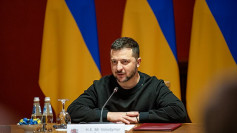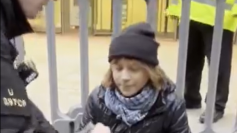As Ukrainian air defenses repelled a pre-dawn Russian attack on the small western city of Starokostiantyniv, explosions illuminated the sky, underscoring the escalating challenges Kyiv faces. This city, home to an important air base, has become a frequent target for Moscow's strikes, particularly as Ukraine prepares to deploy its first U.S.-designed F-16 fighter jets. The anticipated arrival of these aircraft has intensified Russian efforts to cripple Ukrainian air capabilities.
The June 27 assault served as a stark reminder of the perils Ukraine encounters while rebuilding its air force. The average streets of Starokostiantyniv quickly returned to normal, but the threat loomed large. Officials have yet to disclose the F-16s' basing locations, but Russia's recent strike on Starokostiantyniv suggests Moscow's determination to locate and destroy these advanced jets.
"The details in the record will be outrageous to decent people," said city official Vasyl Muliar, acknowledging the constant danger residents face. The air base has been under regular attack since Russia's February 2022 invasion, facing everything from drones to hypersonic missiles.
Despite the challenges, a Ukrainian air force spokesperson asserted that these strikes would not hinder the delivery or operational use of F-16s. Russia, meanwhile, claimed to have destroyed five Ukrainian SU-27 fighter jets at Myrhorod airfield in the Poltava region, though Ukraine disputes this, suggesting the damage was exaggerated.
Military analysts believe that Russia's strategy involves targeting infrastructure such as runways and storage facilities to complicate the deployment of F-16s. "Any ground-based air defense coverage can be saturated if the Russians care enough to fire enough missiles at one target," said Justin Bronk of the Royal United Services Institute.
Residents of Starokostiantyniv have adapted to the frequent attacks. Iryna Sapchuk, editor-in-chief of the local newspaper Our City, described how her parents' home was hit in a previous raid. "They found debris from a missile in a cherry tree by the window," she said. The community continues to project resilience, with road works ongoing and families enjoying local amenities despite the war.
Meanwhile, Hungarian Prime Minister Viktor Orban visited Kyiv, marking his first trip since the war began. Orban, a controversial figure in European politics due to his close ties with Putin, urged President Volodymyr Zelensky to consider a ceasefire to expedite peace talks. "I asked the president to think about whether we could reverse the order and speed up peace talks by making a ceasefire first," Orban said.
Orban's visit highlighted his intent to improve relations with Ukraine, strained by his stance on the conflict and Hungary's frequent blocking of EU military support for Kyiv. He proposed a bilateral agreement to aid in the modernization of Ukraine's economy, signaling Hungary's willingness to participate in rebuilding efforts.
The Hungarian leader's visit came as he assumed the EU Council's rotating presidency, offering him a platform to influence the EU's priorities. This timing suggests Orban's strategic positioning ahead of significant European diplomatic events, including a NATO summit in Washington and a European Political Community meeting in the UK.
Russia's attack on Ukraine's Myrhorod air base, purportedly destroying several Ukrainian fighter jets, underscores the ongoing aerial conflict. Russia's Defense Ministry shared footage of the strike, although Ukraine's air force declined to comment on the authenticity of the footage. NASA's Fire Information for Resource Management System indicated a fire at the location, consistent with the base targeted in the video.
Both Russia and Ukraine have targeted each other's air bases and expensive assets. Ukraine has struck Russian bases deep within Russia and in annexed Crimea, while Russia has consistently aimed to deplete Ukraine's air capabilities. The anticipation of F-16 deliveries has only intensified these efforts.






